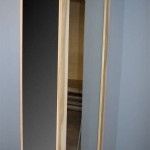Removing Glass Wall Mirrors: A Comprehensive Guide
Removing a glass wall mirror can seem like a daunting task, but with the right tools and techniques, it can be done safely and efficiently. Whether you're renovating, redecorating, or simply want to try a new aesthetic, this guide will provide you with the necessary information to navigate the process successfully. This article outlines the key steps involved in removing a glass wall mirror, covering the different types of installation methods and the potential challenges you may encounter.
Assessing the Mirror's Installation Method
The first step is to determine how the mirror is attached to the wall. Here are the common methods:
- Adhesive: This involves using a strong adhesive to secure the mirror directly to the wall. This method is usually employed for smaller mirrors or decorative accents.
- Brackets or Clips: Larger mirrors often rely on brackets or clips attached to the wall, with the mirror secured to these fixtures. This method ensures robust support and stability.
- Mortar: While less common in modern installations, some older mirrors may be embedded in a mortar bed, providing a permanent and durable attachment.
Identifying the installation method is crucial, as it dictates the tools and techniques you'll need to use for removal.
Tools and Materials
To safely and effectively remove your glass wall mirror, you will need the following tools and materials:
- Safety Glasses: Protecting your eyes from broken glass is paramount. Wear safety glasses throughout the removal process.
- Gloves: To avoid cuts and scratches, use gloves when handling glass or sharp tools.
- Putty Knife or Chisel: For prying loose the adhesive or brackets, a putty knife or chisel is essential.
- Hammer: Used in conjunction with a chisel to gently tap and release the mirror from the wall. A rubber mallet is preferred to avoid damaging the surrounding area.
- Utility Knife: If the mirror is held with adhesive, a utility knife can be used to score the adhesive and facilitate separation.
- Heavy-Duty Plastic Sheeting: Place plastic sheeting on the floor to protect it from falling glass fragments.
- Bucket and Trash Bags: Used for safely collecting and disposing of the broken glass.
- Ladder or Sturdy Stool: Ensure you can safely reach the mirror and work comfortably.
Having these tools readily available will streamline the removal process.
Removing the Mirror
Once you have identified the installation method and gathered your tools, you can begin the removal process. This involves the following steps:
- Preparation: Clear the area around the mirror, removing any obstacles that could impede the process. Cover the floor with heavy-duty plastic sheeting to protect it from falling glass. Wear safety glasses and gloves for protection.
- Loosening the Mirror: If the mirror is attached with adhesive, use a utility knife to score the adhesive along the edges of the mirror. This weakens the bond and makes it easier to separate the mirror from the wall. If the mirror is held with brackets or clips, use a putty knife or chisel to gently pry them away from the wall.
- Removing the Mirror: After loosening the adhesive or brackets, use a putty knife or chisel to carefully work your way around the mirror. Slowly and gently separate the mirror from the wall, starting at the bottom and working your way up. If the mirror is attached with mortar, carefully break it away from the wall using a chisel and hammer.
- Cleaning and Disposal: Once the mirror is removed, clean the wall, removing any remaining adhesive, brackets, or mortar. Carefully collect all broken glass fragments and dispose of them in a secured trash bag.
Following these steps will help ensure a safe and effective removal of your glass wall mirror.
Challenges and Considerations
While the removal process is generally straightforward, you may encounter some challenges:
- Fragile Glass: Glass mirrors are delicate, and any rough handling could lead to breakage. Exercise caution and patience during the removal process. If the mirror is cracked or damaged, it's advisable to call a professional glass removal service.
- Sticky Adhesive: Removing adhesive residue can be a challenge. Use a suitable adhesive remover to dissolve and wipe away the glue. Be sure to follow the manufacturer's instructions for safe application.
- Wall Damage: In some cases, removing a mirror may cause damage to the underlying wall surface. If the mirror was attached with mortar or a strong adhesive, there may be some patching and repainting necessary.
It's crucial to be prepared for potential challenges and have the necessary tools and materials to address them efficiently.

How To Remove A Mirror Glued The Wall Forbes Home

How To Remove A Bathroom Mirror Lowe S

Diy Project Removing Floor To Ceiling Mirrors From A Wall In Our House S Dining Room Jeff Geerling

How To Safely And Easily Remove A Large Bathroom Builder Mirror From The Wall Site Title

How To Safely Remove A Wall Mirror Diy Network

How To Safely And Easily Remove A Large Bathroom Builder Mirror From The Wall Site Title

How To Remove Glass Mirror From Your Bathroom Wall Doctor

Removing A Glued On Mirror From Wall

How To Remove A Bathroom Mirror Lowe S

How To Safely Remove A Wall Mirror Diy Network







